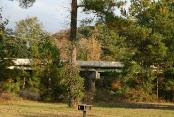 |
| Civil War era church in Campbellton |
As the war had progressed and larger and larger numbers of men and boys went away to fight on the main fronts, Alabama turned for much of its defense to a state militia organization. Companies were organized in counties across the state, with regiments formed from every few counties. These operated under the command of regimental officers, while the local commanders were elected by the men themselves.
 |
| Original Salt Kettle at St. Andrew Bay, Florida |
On September 27, 1864, as Union troops under Brigadier General Alexander Asboth attacked the Florida city of Marianna, a detachment of Dale County militiamen were making their way nearby with an oxcart loaded with salt. They had somehow missed the Federal column as it made its way to Marianna that morning, but things took a tragic turn when they reached the stateline town of Campbellton that afternoon.
 |
| Lt. Col. A.B. Spurling, 2nd Maine |
Spurling and his men donned Confederate uniforms and took off into the stateline country. Please click here to read more about his brief visit to Geneva, Alabama.
They reached Campbellton at the same time as the Dale County men and, according to an account of Spurlings operations, captured an "army wagon" and three Alabama militiamen.
Tragically, these three men disappear from the record and are never heard from again. Local tradition in Dale County holds that they went off to "get salt at the bay and never came home." Their fate seems to have been dark.
Spurling and his men were operating undercover, behind enemy lines. Because they were wearing Confederate uniforms, they knew that if they were detected they would face immediate execution as spies. Carrying along prisoners could prove fatal to the colonel and his men if they stumbled across a Confederate patrol. This left them with only two options: 1) release the men, and 2) kill them.
Since the men never returned home, the only logical conclusion is that they were taken into the woods and killed by the undercover Federals. Their bones likely rest somewhere near the state line in Jackson County, Florida, to this day.
To learn more about the 1864 Marianna Raid and Spurling's undercover activities, please consider my book: The Battle of Marianna, Florida: Expanded Edition
It is also available as an instant download for Amazon Kindle and iBooks devices. You can also read more about the raid at www.battleofmarianna.com.




